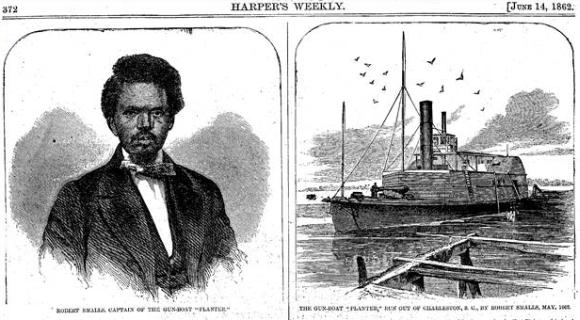 Here is a story well worth retelling; an updated repost in honor of Black History Month; the remarkable story of Robert Smalls.
Here is a story well worth retelling; an updated repost in honor of Black History Month; the remarkable story of Robert Smalls.
On May 13, 1862, Robert Smalls, a 23-year-old slave, who served as the pilot of the Confederate armed transport, CSS Planter, led eight fellow slaves in an audacious flight to freedom. They seized the CSS Planter, steamed it out past the batteries and forts of Charleston harbor, and turned it over to the Union naval blockade. Smalls would go on to become the first black captain of a U.S. Navy vessel, a South Carolina State Legislator, a Major General in the South Carolina Militia, a five-term U.S. Congressman, and a U.S. Collector of Customs.
Harper’s Weekly of June 14, 1862, recounts the escape:
One of the most heroic and daring adventures since the war commenced was undertaken and successfully accomplished by a party of negroes in Charleston on Monday night last. Nine colored men, comprising the pilot, engineers and crew of the rebel gunboat, Planter, took the vessel under their exclusive control, passed the batteries and forts in Charleston harbor, hoisted a white flag, ran out to the blockading squadron, and thence to Port Royal, via St. Helena Sound and Broad River, reaching the flagship Wabash shortly after ten o’clock last evening…
The Planter is a high-pressure, side-wheel steamer, one hundred and forty feet in length, and about fifty feet beam, and draws about five feet of water. She was built in Charleston, was formerly used as a cotton-boat, and is capable of carrying about 1,400 bales. On the organization of the navy, she was transformed into a gun-boat, and was the most valuable vessel the Confederates had at Charleston. Her armaments consisted of one 32-pound rifle gun forward, and a 24-pound howitzer aft. Besides, she had on board when she came into the harbor one seven-inch rifled gun, one eight-inch Columbiad, one eight-inch Howitzer, one long 32-pounder, and about two hundred rounds of ammunition, which had been consigned to Fort Ripley, and which would have been delivered at that fortification on Tuesday had not the designs of the Rebel authorities been frustrated. She was commanded by Captain Relay [sic], of the Confederate navy – all the other employees of the vessel, excepting the first and second mates, being persons of color.
The black engineers raised steam on the Planter, which left the dock at 3AM. The American Civil War had begun in the harbor of Charleston, South Carolina in 1861 with the rebel attack on Fort Sumter. In order to escape, Robert Smalls would have to navigate the Planter past the guns of Fort Sumter. The current was against them, however, and they didn’t pass Fort Sumter until after dawn. Smalls donned the white shirt and naval jacket of the captain along with his distinctive straw hat. As they neared the fort, they gave the appropriate whistle signals and Smalls and the Planter were waved by. Once within range of the Union ships, Smalls struck the Confederate flag and raised a white flag made from a bedsheet.
The Planter was carrying as cargo one seven-inch rifled gun, one eight-inch Columbia, one eight-inch Howitzer, one long 32-pounder, and about two hundred rounds of ammunition, in addition to her own guns, which included one 32-pound rifled gun forward, and a 24-pound howitzer aft. As Planter came alongside the Union ship, Smalls is said to have raised his hat high in the air and shouted, “Good morning, sir! I have brought you some of the old United States’ guns, sir!”
Perhaps more valuable than the guns, Small also gave Union Admiral Du Pont a rebel naval codebook and information on the harbor defenses and the location of rebel troops.
Robert Small was awarded $1,500 as his share of the prize money from the CSS Planter, which was taken into the US Navy as the USS Planter. In August 1862, Smalls traveled to Washington, D.C. to meet with Secretary of War Stanton and President Lincoln. He persuaded the president to permit black men to fight for the Union, receiving orders signed by Stanton permitting up to 5,000 African Americans to enlist in the Union forces at Port Royal.
Smalls then acted as pilot for the Union Navy around Charleston, serving as pilot on the Union ironclad Keokuk during a failed Union attack on Fort Sumter in April 1863. In December 1863, Smalls was made pilot on his old ship, renamed the USS Planter. Caught in a crossfire between Confederate and Union ships, the captain decided to surrender. Smalls, concerned that the black sailors aboard would be sold back into slavery or perhaps, be shot, once again took control of the Planter, piloting the ship to safety. In recognition of his bravery, Smalls was made the captain of the USS Planter, becoming the first black captain in the US Navy.
After the war, Smalls became a major general in the South Carolina militia and a state legislator. He participated in drafting the constitution of the state in which he had been a slave. He was the most powerful black man in South Carolina for five decades. Robert Smalls served five terms as a U.S. Congressman during Reconstruction. For nearly 20 years he served as U. S. Collector of Customs in Beaufort, S.C., where he lived as owner in the house in which he had been a slave.
There are currently two US government vessels named after Robert Smalls — one Army and one Navy. In 2007, the logistics support vessel Major General Robert Smalls (LSV-8) was named in his honor.
In 2023, the Ticonderoga-class guided-missile cruiser CG-62 was renamed USS Robert Smalls. The cruiser had formerly been named USS Chancellorsville to commemorate a Confederate victory during the Civil War.
